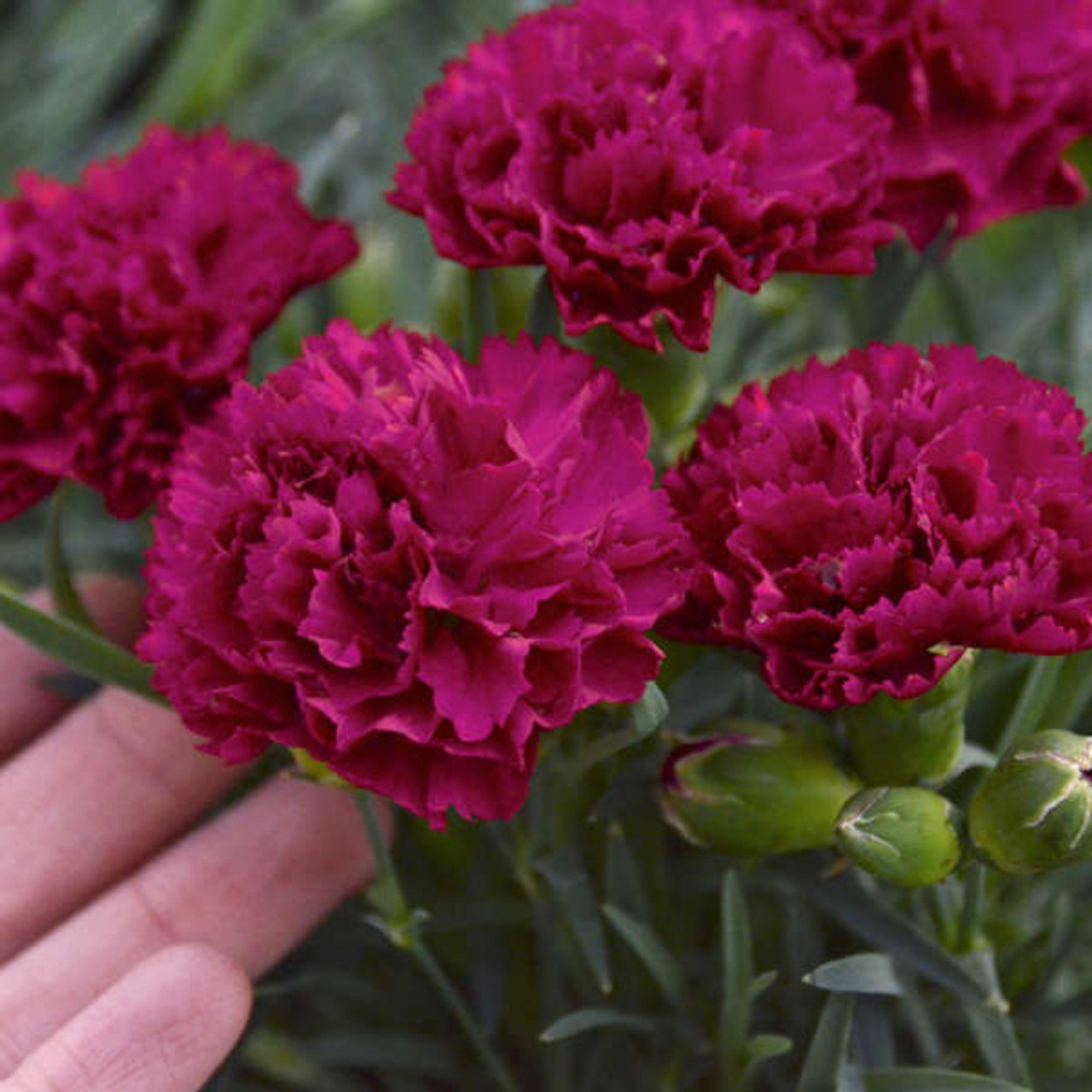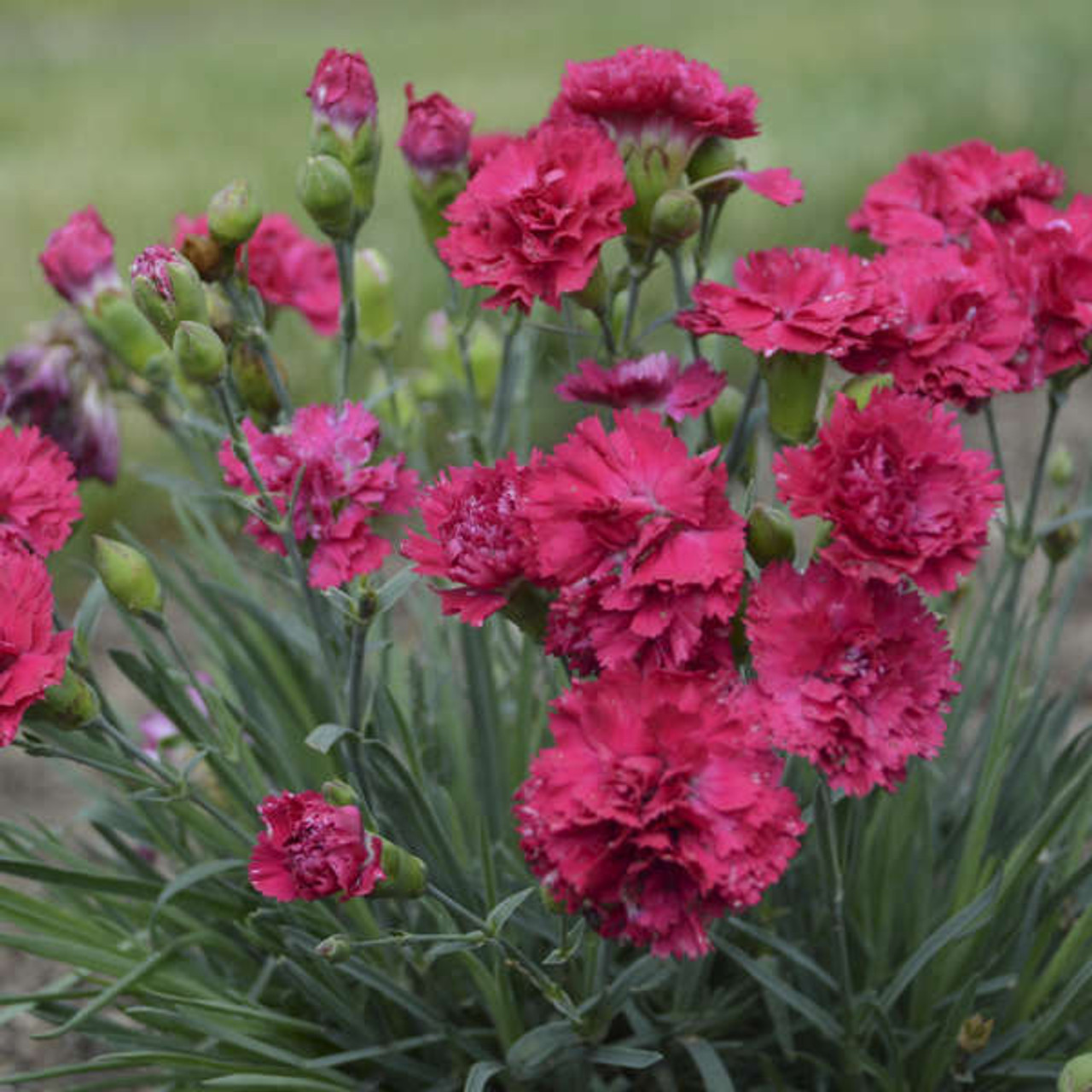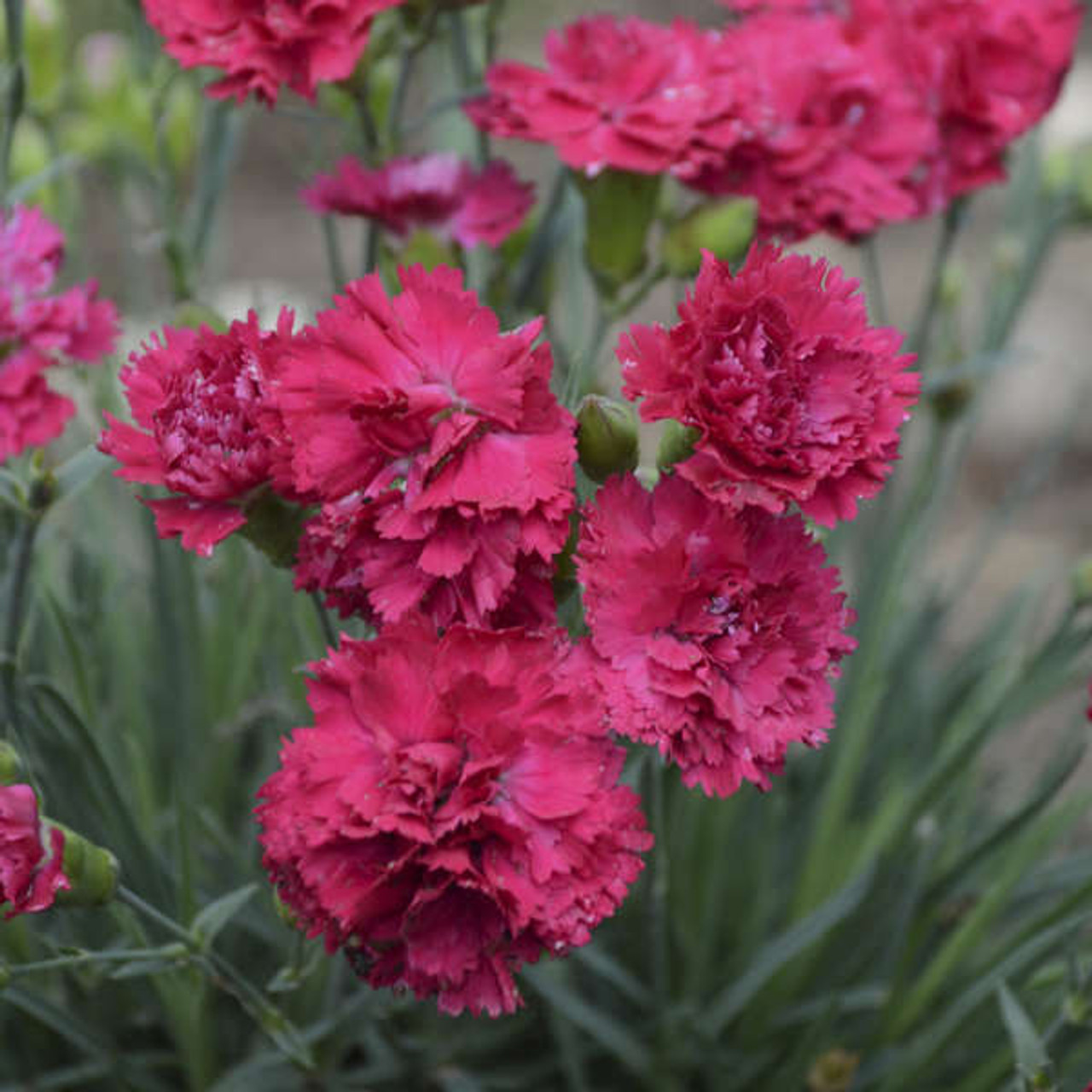Product Description
Dianthus 'Cranberry Cocktail' PP28603 CPBR5814 (30)ct Flat
FRUIT PUNCH® Series
Common Name: Pinks
The large flowers of ‘Cranberry Cocktail’ look and smell like mini-carnations—and you can enjoy them in your garden and in cut bouquets alike. Full, 2” double hot magenta pink flowers have serrated edges, rising above its grey-green, dense foliage.
Members of the Dianthus FRUIT PUNCH® series share the following traits: semi to fully double, fragrant flowers, and good heat and humidity tolerance. Flowers appear in early summer, and a quick shearing after flowering will encourage them to rebloom in early fall. FRUIT PUNCH® Dianthus are just the right size to edge the front of the sunny border and use in combination containers.
In the carnation family, Dianthus cultivars deliver gorgeous single, semi-double, and fully double flowers. Singles tend to deliver more flowers while doubles are significantly larger, sometimes more than twice the size. Singles also tend to grow quicker and can appear like a carpet in the landscape at maturity.
Dianthus grow best in loose, well-drained, neutral to slightly alkaline soils. Lime can be added to the soil if it is naturally acidic to raise the pH. Dianthus can be grown in full sun or part shade, but the foliage will not be as lush and fewer flowers will be produced if it is grown in hot, dry areas. Regular watering during prolonged dry spells will be necessary. However, they are tolerant of short periods of dryness.
Do a thorough clean-up in the fall to prevent pest and disease problems and add a layer of mulch to protect the evergreen foliage. As soon as the weather begins to warm up, remove all of this mulch to prevent crown rot.
Height: 6.0-8.0 Inches
Spread: 12.0-14.0 Inches
Hardiness Zones: 4,5,6,7,8,9
Flower Color: Red shades
Foliage Color: Green shades
Full Sun (> 6 hrs. Direct Sun) - Part Shade (4-6 hrs. Direct Sun)
Low to Average Water Needs
Average Soil Quality
Bloomtime: Early Summer - Early Fall
Attracts Butterflies
Bee Friendly
Seasonal Interest: Dried Seed Heads
Evergreen
Growth Rate: Medium
Border Plant, Container, Cut Flower, Dried Flower, Drought Tolerant, Easy To Grow, Fragrant Flowers, Fragrant Foliage, Mass Planting, Salt Tolerant, Small
Dianthus 'Cranberry Cocktail' is a charming evergreen perennial and a member of the Fruit Punch series. This lovely plant produces masses of fragrant, double, carnation-like flowers. The blooms are a vibrant hot magenta pink with serrated petals and measure about 2 inches across. This compact plant typically grows to be 8-10 inches tall and 12-14 inches wide. It is an excellent choice for adding a splash of color to gardens, borders, pathways, and rock gardens.
Dianthus 'Cranberry Cocktail' is a low-maintenance plant that is heat, drought, and salt-tolerant. It is also deer-resistant. The blue-green foliage provides year-round interest. The flowers bloom from early summer through early autumn , attracting butterflies and bees to your garden. Interestingly, Dianthus flowers are edible, with the individual petals having a sweet taste that matches their perfumed scent.
How to Grow and Care for Dianthus 'Cranberry Cocktail'
- Soil Dianthus 'Cranberry Cocktail' prefers loose, well-drained soil that is neutral to slightly alkaline. If your soil is acidic, you can add lime to raise the pH. Ideally, the soil should be fertile and somewhat gritty loam with good drainage.
- Sunlight Dianthus 'Cranberry Cocktail' thrives in full sun to part shade. It prefers at least 6 hours of sunlight daily for optimal flowering. While it can grow in part shade, it may not produce as many flowers in those conditions.
- Watering Dianthus 'Cranberry Cocktail' has average water needs. It is drought-tolerant once established, but you should water it regularly during hot, dry weather. Avoid overwatering, as this can lead to root rot.
- Fertilizing Dianthus 'Cranberry Cocktail' does not require heavy fertilization. One application of garden fertilizer in early spring is usually sufficient.
- Winterizing In colder climates, it is a good idea to provide some winter protection, such as mulch, to safeguard the plants. Remove all dead and fallen plant matter to prevent rot or damage. The best mulch for Dianthus 'Cranberry Cocktail' is pea stone or gravel, which helps keep the plant clean and suppresses weeds without holding excess water.
- Maintenance and Pruning Dianthus 'Cranberry Cocktail' requires little to no pruning or maintenance. Deadheading is not required but will encourage additional flower production.
- Hardiness Zones Dianthus 'Cranberry Cocktail' can be grown in USDA hardiness zones 4-9. This means it can tolerate a wide range of temperatures. Here is a breakdown of the average minimum winter temperatures for these zones:
Bloom Time and Duration Dianthus 'Cranberry Cocktail' blooms in early summer and early fall. The flowers typically last for several weeks. Shearing after the first flowering will encourage the plant to rebloom in early fall, extending the enjoyment of these fragrant flowers.
Pests and Diseases While Dianthus 'Cranberry Cocktail' is generally a low-maintenance plant, it can be susceptible to certain pests and diseases. Here is what to watch out for:
Pests
- Aphids: These tiny insects suck sap from plants, causing stunted growth and discolored foliage. You can often spot them on the undersides of leaves or on new growth. To treat an aphid infestation, you can spray the foliage with insecticidal soap.
- Spider mites: These small pests can cause yellowing and stippling of leaves. They are often difficult to see with the naked eye, but you may notice fine webbing on the plant.
- Slugs: Slugs can devour foliage and flowers, leaving irregular-shaped holes. They are most active at night and after rain. You can remove them by hand or use slug traps.
Diseases
- Powdery mildew: This fungal disease appears as a white powdery coating on leaves and stems. It can be caused by poor air circulation and high humidity.
- Rust: Rust appears as reddish-brown pustules on leaves. Like powdery mildew, it can be caused by poor air circulation and high humidity.
To prevent these diseases, ensure good air circulation around your plants and avoid overhead watering.
Companion Plants Dianthus 'Cranberry Cocktail' pairs well with a variety of other plants. Some recommended companion plants include:
- Nepeta 'Cat's Pajamas' (Catmint)
- Echinacea Sombrero Adobe Orange (Coneflower)
- Heuchera 'Black Taffeta' (Coral Bells)
- Monarda 'Bubblegum Blast' (Bee Balm)
History and Origins of Dianthus The name Dianthus comes from the Greek words "dios" (divine) and "anthos" (flower). Dianthus plants have been cultivated for over 2,000 years and are native to Europe and Asia. They were popular in ancient Greece and Rome, where they were used in garlands and perfumes. Today, there are over 300 species of Dianthus, with a wide variety of colors and forms.
Dianthus 'Cranberry Cocktail' is a beautiful and versatile plant that is easy to grow and care for. With its vibrant, fragrant, and edible flowers, long bloom time, and low-maintenance nature, it is an excellent choice for any garden. This charming perennial thrives in a variety of settings and offers a delightful splash of color throughout the growing season. By following the growing and care tips outlined in this article, you can ensure that your Dianthus 'Cranberry Cocktail' thrives and provides you with years of enjoyment. Remember to deadhead spent blooms to encourage reblooming and shear after the first flowering to promote a second bloom in the fall. With proper care, you can enjoy these lovely flowers from early summer through early autumn.
Thirty (30) plants per flat (or tray). Approximate Plug Measurements: 3 inches deep x 2 inches wide.
Other Details
The most important part of the plant is its root system. Healthy roots are the foundation of a healthy, vibrant plant. The type of plug container used is based on the specific needs of the plants. Perennials offered as bare root traditionally perform better when planted as bare root.Planted in a specialized mix, potted plants have well established root systems. Top growth stage will vary depending on the current life cycle and time of year when shipped. In Winter and early Spring dormant plants may be shipped. Dormant plants may be planted right away, even before the last frost date.
Most bare root varieties are field grown for at least one season, though Hemerocallis and Hosta are grown for two seasons. The bulk of the soil is removed during the harvesting process and the tops of most varieties are trimmed back to the crown. They are graded, packed in shredded aspen or sphagnum moss and stored in freezers until ready to be shipped.
See our Container Sizes and Bare Root Perennials pages for more information.
Plant information and care is provided in the Overview section, Plant Genus Page and general information is provided in the Planting Care & Guides. Additional questions can be asked on each Plant page.
Plant Spacing: Using the maximum mature spread or width of a plant to guide spacing, ensures space to grow to full size. To fill an area sooner, plant them closer together. Just remember, future thinning or transplanting may be needed.
Water: Keep a close eye on newly planted perennials, especially throughout the first growing year. Most early plant loss is due to too much or too little water!










